

A New Project Although this project has been on a back burner almost since Robert showed me his first draft, I've only recently begun the research stage. First and foremost, I will need a scarab. I want to use a local beetle. So on the afternoon of October 1st, I visited Peggy & Cary's horse pasture to poke around in manure piles with the hope of finding a dung beetle. I knew it was awfully late in the season to begin my search, but I was delighted to find (in fresh piles only) a small candidate for my project: |
|
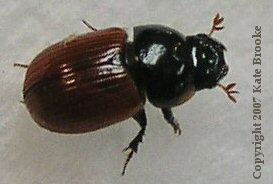 |
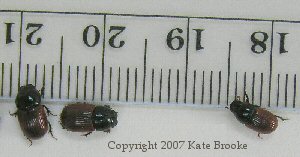 |
| Into my zip-lock bag went a handful of horse apples with some beetles. I brought home my specimens and set up a fish bowl terrarium with a layer of dirt on the bottom and the horse manure on top of that: | |
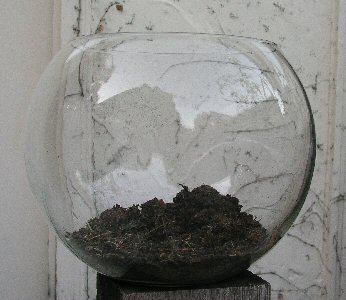 |
|
Robert objected to my keeping this beetle habitat in the house. I moved it to my studio, where I took an initial set of photographs to help with identification. Although it seemed clear it was a dung beetle, I didn't learn anything more specific. As I read more about dung beetles in general, I found that not all of them are dung rollers. It is essential to Robert's story that the beetle be a dung roller, so I needed to find out who this little one was, and how it behaved. None of my field guides or my copy of Jaques' How to Know the Beetles had this particular scarab in it; I also had no luck searching the Internet. Shortly after being relocated to my studio, the little beetles disappeared into the dirt. I periodically moistened the soil and wondered what it was they were doing in there. Dying, maybe? Then on the 29th of October I dampened the soil when I went to work, and two of the resident beetles emerged and crawled around. Soon at least half a dozen were active, most of them crawling on a slightly wet paper towel I had put in there. I got out my camera and started photographing. Shaping the paper towel into uneven terrain allowed me to observe the beetles climbing up and down and turning this way and that, exactly the kinds of poses I would need for my drawings. In the macro photographs the paper towel becomes a landscape that in some cases reminds me of something Dr. Seuss would have created: |
|
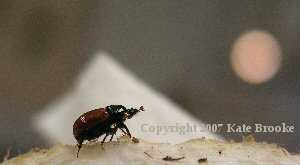 |
|
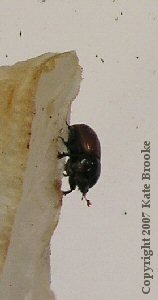 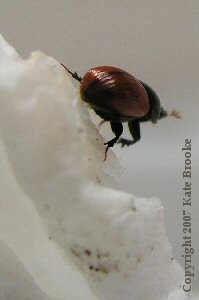 |
|
| One of the beetles was determined to fly, but it didn't manage to get very far: | |
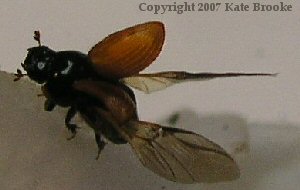 |
|
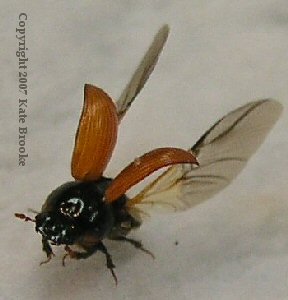 |
|
| Notice on the above beetle's left wing casing there is a small whitish blur. As I took these photos I wondered about occasional whitish gray spots on some of the beetles. Did they have mold on them? When I examined my photographs, I found the spots were even smaller creatures: | |
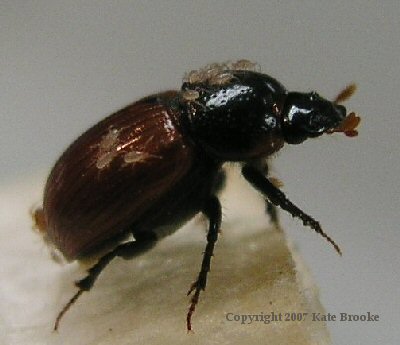 |
|
I wrote to Soni Cochran at the UNL Extension office to see if she could identify both the beetle and the smaller bugs clinging to it. Soni referred me to Barb Ogg, who told me the smaller bugs are phoretic mites: "You are witnessing phoretic mites associated with these scarab beetles. The word "phoresy" refers to the situation when a relatively immobile animal (the wingless mite) catches a ride with a more mobile animal (the dung beetle). I am assuming these mites are associated with dung and travel to "fresh" piles by hanging onto the beetle. The beetles probably had one or two mites on them when you caught them (sometimes they hide under the wing covers) and they (the mites) have been breeding prolifically in the favorable conditions of your fish bowl." Barb then referred me to Brett Ratcliffe, who identified the beetle as Onthophagus fimetarius. He told me there is no common name, and these are not dung rollers. What he suggested I look for --beginning in May -- is a tumblebug, or Canthon pilularius, found in pastures throughout most of Nebraska. Tomorrow being Hallowe'en, it's too late to find any active now. I am disappointed this is not a dung roller. I've grown rather fond of this little beetle and have collected good material from which to start drawings. That's okay. I will use these materials elsewhere, and in the meantime will continue to learn what I can from these non-rollers. I believe the tumblebug is entirely black and more round in shape. While I can use my pictures of Onthophagus fimetarius for reference in developing preliminary ideas for my drawings, I'll need to avoid relying too much on their shape and coloration. I may still be able to use these photographs to cartoon the eventual beetle hero of the story. Meantime, I have plenty else to do for the project. Robert's story includes other creatures: a sparrow, a mouse, an ibis, a cow, a cat, a horse, an owl, and more. I won't insist these all be based on local animals. And this is where I will leave off for tonight. |
|
Click here to return to the Flora & Fauna page.
© Copyright 1997 - 2007 and beyond. None of these images, or any portion thereof, may be used without written permission from the artist, Kate Brooke. |
This page was last updated on September 24, 2008 |